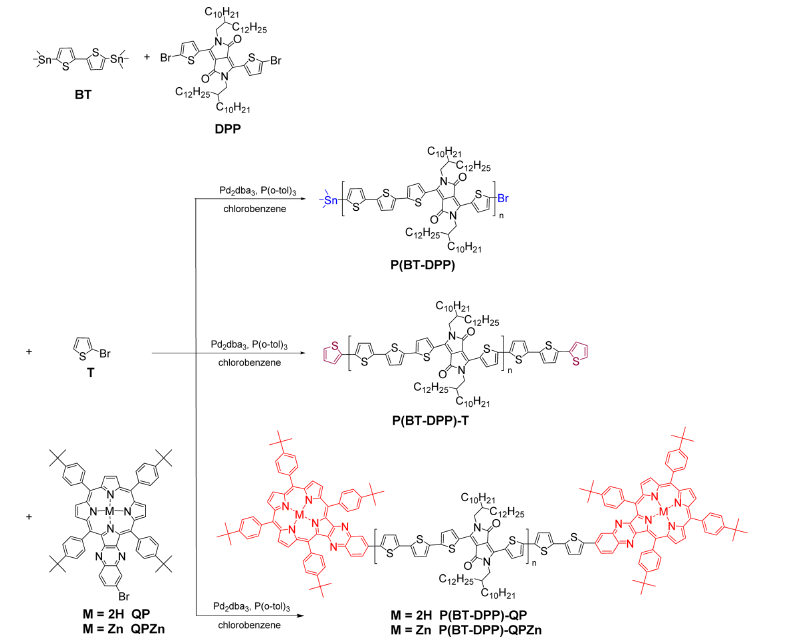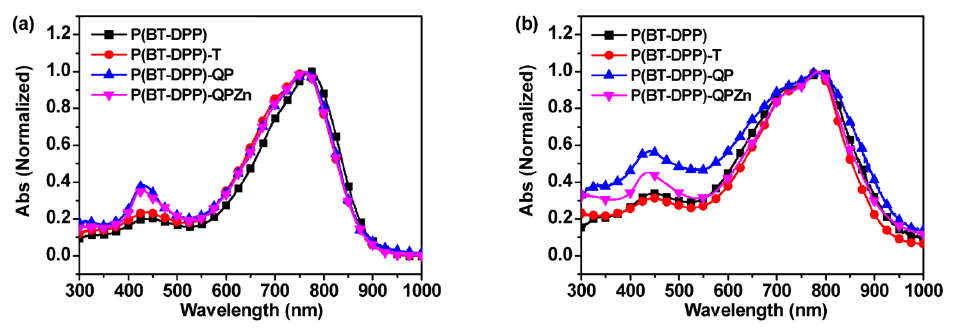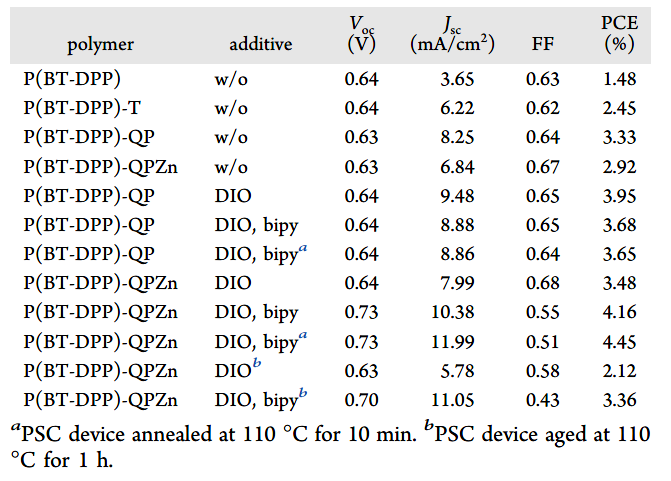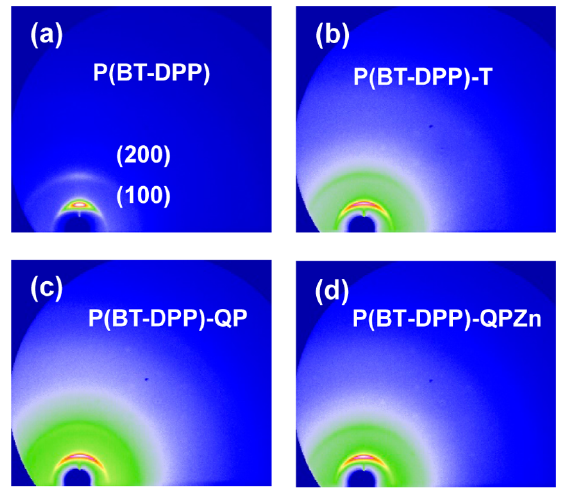| End-Capping Effect of Quinoxalino[2,3-b′]porphyrin on Donor Acceptor Copolymer and Improved Performance of Polymer Solar Cells | ||||||
| From: PublishDate:2017-06-16 Hits: | ||||||
Polymer solar cells (PSCs) have emerged as promising alternatives to inorganic photovoltaic devices due to their potential advantages of low cost, lightweight, and capability to be fabricated into flexible devices. The conjugated polymers for photovoltaic materials with higher molecular weights were reported to be more likely to gain better device performance. But the conjugated polymers are generally strong rigid, which implies limited solubility in organic solvent and the resulted polymers often show limited molecular weights for considering their processibility. Under this circumstance, the end-group effect of polymers would be very prominent. Traditionally, donor-acceptor polymers synthesized by Stille-coupling polymerization without subsequent end-capping process would contain residual unreacted stannyl and bromide functionalities at the end groups. These residual unreacted functionalities are considered as structural defects that deteriorate the overall device performance by charge trapping, photogenerated excitons quenching, chain packing, or film morphology.
In these research, a series of end-capped donor-acceptor copolymers, P(BT-DPP)-T, P(BT-DPP)-QP, and P(BT-DPP)-QPZn, were synthesized by Stille coupling of 2,2′-bithiophene (BT) and diketopyrrolopyrrole (DPP) with end-caps of thiophene (T), quinoxalino[2,3-b′]porphyrin (QP), and quinoxalino[2,3-b′]porphyrinatozinc (QPZn), respectively. Compared with the counterpart, P(BT-DPP), which contains no end-caps, P(BT-DPP)-QP and P(BT-DPP)-QPZn showed remarkably enhancement of light absorption in the range of ca. 400-550 nm resulted from the end-capping effect of porphyrins.
Bulk heterojunction polymer solar cells (BHJ PSCs) based on these polymers were fabricated and the results showed signi?cant improvement of power conversion e?ciencies (PCEs) of the end-capped polymers. Especially, ligand additive, 4,4′-bipyridine (Bipy), was applied to the PSCs based on polymers end-capped by porphyrins and the PCE of the photovoltaic device based on P(BT-DPP)-QPZn significantly improved from 2.92% to 4.45% with the comprehensive benefits of optimization strategies such as using additives and thermal annealing. Furthermore, thermal aging experiments showed increased stability of the optimal morphology of P(BT-DPP) QPZn-PC71BM blend ?lm after the use of Bipy. After thermal aging at 110 °C for 1 h, the PSC processed with only DIO showed a PCE of 2.12%, which retained only 61% of its initial PCE. However, the PSC processed with both DIO and Bipy showed a PCE of 3.36%, which retained 76% of PCE. We suppose that the use of Bipy would stabilize the photoactive layer, leading to the decreased degradation in the condition of device aging. The results showed much similarity to the increased stability of optimal morphology caused by cross-linkable additives.
Table 1 Photovoltaic Properties of the PSCs Based on Polymer:PC71BM (1:1, w/w) under Illumination of AM1.5G, 100 mW/cm2. aPSC device annealed at 110 °C for 10 min. PSC device aged at 110°C for 1 h.
Two-dimensional grazing incidence X-ray diffraction (2D-GIXRD) measurement was performed to study the crystallinity of the polymer ?lms based on different end-caps. As shown in Figure 1, the film of P(BT-DPP) without end-caps showed a strong (100) diffraction peak and a weak (200) diffraction peak, indicating strong crystallinity of P(BT- DPP). The fllm of P(BT-DPP)-T, P(BT-DPP)-QP, and P(BT- DPP)-QPZn with end-caps of T, QP, and QPZn, respectively, also showed (100) and (200) diffraction peaks, but with relatively large arcing of diffractions, indicating that the end-caps reduced the crystallinity of polymers. However, compared with other donor-acceptor conjugated polymers, the crystallinity of these polymers with end-caps was still considered to be strong.
This study provides a promising strategy to design donor-acceptor copolymers with multifunctional end-caps and to use ligand additives for achieving PSCs with both high-efficiency and long-term stability, which are critical for the devices to be commercially useful.
Article: Liwei Wang, Zi Qiao, Chen Gao, Junwen Liu, Zhi-Guo Zhang, Xiaoyu Li, * Yongfang Li, and Haiqiao Wang*, End-Capping Effect of Quinoxalino [2, 3-b′] porphyrin on Donor–Acceptor Copolymer and Improved Performance of Polymer Solar Cells, Macromolecules, 2016, 49 (10), pp 3723–3732
|
||||||
|
|
| Chinese
- Metal-free efficient photocatalyst for stable visible water splitting——Top ten major scientific progresses in China in 2015
- The nano-resolution imaging platform was awarded the first rate prize of Beijing Science and Technology in 2014
- Beamline 1W1 of BSRF started to runoperate in the couplingparasitic mode of BEPCII
- Synthesis of High Performance Polymer Materials for Field Effect-Transistors
- Surfactant molecular aggregates in green solvents
- GIXRD has played an important role in the characterization of organic thin-film transistors
Science Highlights
Home /
Copyright © 2011 - 2012 Beijing Synchrotron Radiation Facility





